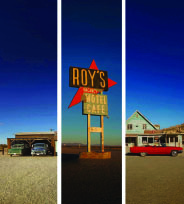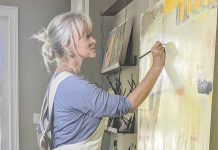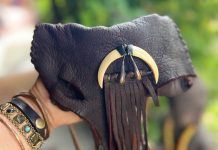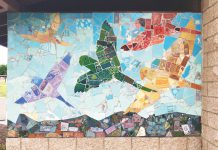Virginia-based painter Susan Jamison and Parisian-turned-Angeleno photographer Olivier Pojzman commonly depict certain archetypes and themes, subtly exploring larger questions of cultural identity.
Section by Hannah Ostrow

Susan Jamison (The George Gallery)
Home base: Roanoke, Va.
Background: MFA in painting from Rhode Island School of Design
Media of choice: Primarily paintings in egg tempera (the principal medium in painting up until the 16th century, when it was overshadowed by the popularization of oil painting), as well as graphite drawings with occasional touches of watercolor and gouache
Previously shown in: Virginia, Washington, D.C., Miami, New York, Winston-Salem, N.C., San Marcos, Texas
Work: We see a thematic trend in Susan’s paintings: the head and torso of a nude woman, usually in profile—the veins and muscles and nerves of her head intricately drawn as if her skull were see-through. A delicate, hot pink, floral pattern decorates her skin. She is alternatively threatened by or helped by the animals with which she’s depicted.
Because what she paints is so consistent, we come to see Susan’s task as creating a richly layered archetypal woman. She takes inspiration from a remarkably wide spectrum—according to the artist herself, the anatomically detailed heads pull from 19th century medical illustrations. But Susan’s works recall, too, diagrams from the phrenology craze of the same era, as well as elements of Leonardo da Vinci’s iconic anatomy studies.
The animals these women encounter look straight out of the European fairy tale canon: malicious wolves, docile lambs and chipper, servile birds. The snakes look conniving and the apples tempting, but the allusions are not limited to Western tradition: The floral patterns that invariably adorn the women’s torsos crawl across their skin like henna.
Susan’s archetypal woman is bound simultaneously by society and biology, tied up with all of humanity and all of nature, a sweeping look into what makes up the modern woman.
Susan’s work appears this month as part of “Nature Doesn’t Knock” at The George Gallery, Sept. 1 – Oct. 31. (949-715-4377; thegeorgegallery.com)
 Olivier Pojzman (Townley Gallery)
Olivier Pojzman (Townley Gallery)
Home base: Currently lives in Los Angeles, but originally from Paris
Background: Studied art and design in his native Paris before coming to the U.S.
Media of choice: Panoramic photographs digitally stitched together for large-format printing on wood panels or canvas, often presented as diptychs or triptychs
Previously shown in: Los Angeles, Miami, Paris, Palm Desert, Calif.
Work: Dramatic, large-scale photographs of deserted roads, vintage cars, neon motel signs and roadside diners make up the cultural, imaginary landscape surrounding the modern American West. It’s unsurprising, then, to learn that the artist isn’t from the West at all, or even from the U.S., but from France. The starry-eyed vision of the grandeur of the open road could only belong to someone for whom it was all once new, someone who sought out this landscape so wildly different from his own. Someone like Olivier Pojzman.
Think of British expat David Hockney’s 1986 “Pearblossom Highway,” a photo collage of California’s Route 138 that traces the foothills of the San Gabriel Mountains. Despite the barren landscape and the pervasive roadside litter, what’s most memorable in “Pearblossom Highway,” and in Olivier’s updated open-road imagery, are the vast, cloudless sky and the way the road tapers towards a far-off vanishing point. Olivier, too, taps into the grandiose vision of the American West, making his figurative work more abstract and the region’s abstract identity tangible.
Experience Olivier’s photographs in Townley Gallery’s group show through the end of the year. (949-715-1860; townleygallery.com)




